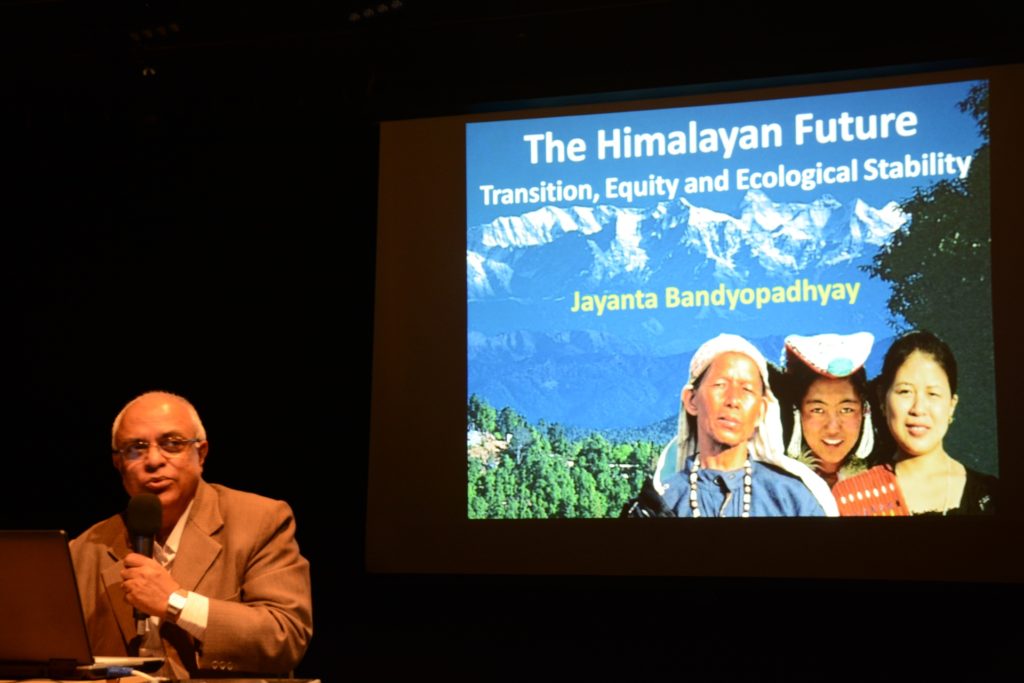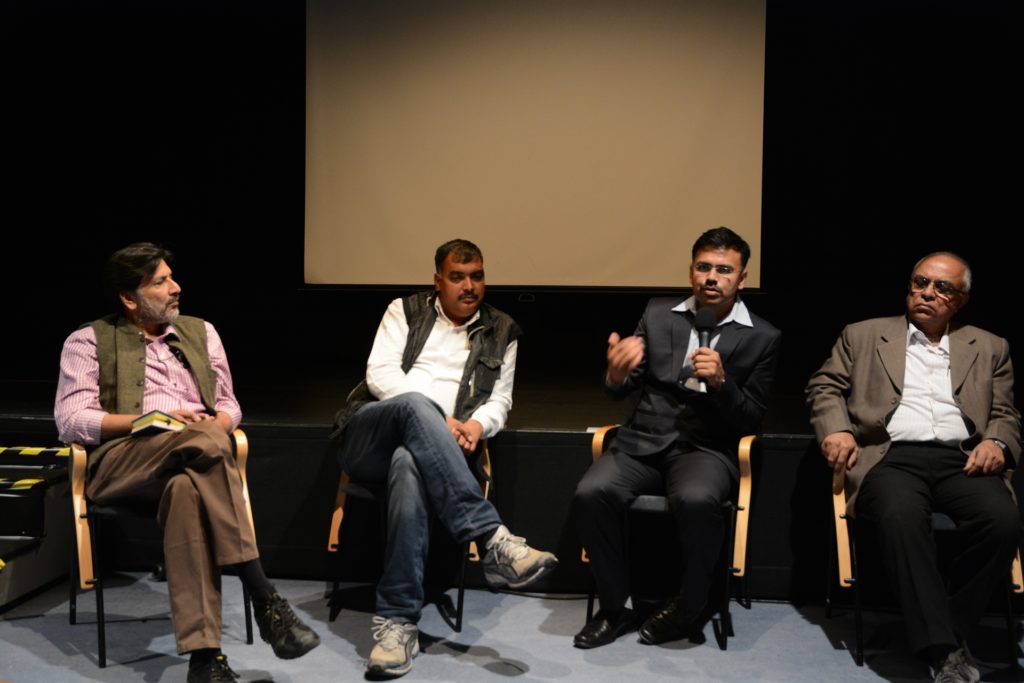[Toni Haapanen] Siemenpuu Foundation’s SADED cooperation programme and the Department of Geography and Geology of the University Turku brought the annual Himalayan Day to Finland on 9th September, 2014. The event, which was held at the International Cultural Centre Caisa in Helsinki, aimed to stir up conversation on the essential role of the Himalayas in the political, economic and socio-cultural development of Southern Asia, and on the challenges that the communities of the Himalayas face as climate change proceeds. The guest speakers of the day came from Calcutta, Delhi and Uttarakhand of India, and the Finnish speakers from the University of Turku, which hosts a research project Livelihood security in a changing socio-economic environment in Himachal Pradesh, India.
The day was opened with a lyrical song called Miss Himalaya by the duo Kukka Harvilahti & Lydia Laine. Then, Bhuwan Pathak, a farmer and activist from SADED, presented how the idea of the annual Himalayan Day was initiated in Dehra Dun in 2010 for celebrating the mountain range and drawing attention to its situation. The popularity of this day has since grown enormously, and over 870 events were organized last year. The Himalayan Day is important for the unity movement of the region, and therefore Mr. Pathak hopes that the celebration would be spread further around the globe.
Professor Jayanta Bandyopadhyay is an environmentalist and author who has recently retired from the Indian Institute of Management in Calcutta. In his presentation (pdf), Dr. Bandyopadhyay highlighted the role of increasing accessibility of the remote parts of the Himalayan region through the rapid construction of roads, railways and communication systems. This has enabled the market forces to penetrate in the relatively isolated communities. Muscle power is being replaced by electrity and diesel, which has tremendously changed the livelihood options and the organization of the mountain communities. Young people generally aspire to move to the growing urban centers and seek employment from non-farm sectors, while the amount of idle agricultural land is increasing. Dr. Bandyopadhyay expressed his concern on how the issues of equity and ecological stability could be raised in the minds of the people taking the path of this rapid market-based transition. The decision-makers do not have in-depth policies in these regards. Also transboundary co-operation would be essential in various aspects concerning the vast Himalayan range, but in reality these initiatives lack confidence and are not sufficient. For example, the recent floods in Jammu and Kashmir created problems in Pakistan, but the transboundary co-operation and aid does not reach the affected communities. Activists need to address this issue and push the governments to act.

Dr. Suraj Mal from the Department of Geography in the University of Delhi has made research on the climatic development (pdf) in the Himalayan region. The studies that he has conducted in India broadly support the IPCC’s view that the glacier retreat in the Himalayas has increased during the recent decades, even if the situations may vary at the local level. However, the availability of historical data from the area is poor, and it is not clear yet whether the retreat is being caused by rising temperatures or decreasing snowfall. The amount and size of glacier lakes have been increasing, and the melting of snow and ice are creating floods and landslides. Last year in Uttarakhand a flash flood destroyed nearly the whole town of Kedarnath, killing thousands of people. When asked about the early warning systems, Dr. Mal replied that these are not sufficient and usually the government only acts after the devastation has already happened.
Tikli Loivaranta from the University of Turku presented her study on a CDM afforestation/reforestation project (pdf) in Himachal Pradesh, India. The CDM project has been funded by the World Bank and implemented by a local body closely related to the Forest Department. Most interviewed people in the communities, however, have not been aware of the linkages of this CDM project with climate change mitigation, and, importantly, that they would be entitled to receive revenues if the plantations were succesful. She addressed that “tool kit” participation of the local communities is not enough, as attention must be paid to the continuous process of interactive participation and dialogue.
Johanna Hänninen from the University of Turku has made research among the Gaddi pastoralists (pdf) in Himachal Pradesh. She described the livelihood patterns of the Gaddis, whose employment in the non-farm sector, seasonal wage labour, and tourism-related activities is now essential. Livelihood-related changes are taking place through e.g. increasing tourism, accessibility, hydro power projects and availability of electricity, and employment opportunities that the large-scale apple farms provide. The current crisis of nomadic pastoralism is accelerated by the conflicts over land with the sedentary communities and the state.

In the panel discussion, Pawan Gupta from Uttarakhand noted that the state institutions have replaced the traditional communities’ laws and practices. Self-respect towards local knowledge and traditions has diminished, whereas everything that comes from outside, particularly the West, is highly respected and adopted. Bhuwan Pathak continued by telling how the human-nature relationship has changed in the area during the last 100-150 years. For example, this process was contributed by the books of a hunter Jim Corbett (1875-1955 ) who portrayed tigers and leopards in Uttarakhand as “man-eaters”, in stark contrast with local perceptions of co-existence with these animals. The relationship with nature was also altered by the beginning of large-scale logging for private trade, building railways and ships, as well as the restrictions of the use of forest resources for household needs during the British colonial era.
Suraj Mal said that he is confused about the situation in the Himalayas and the current solutions for it. In Nanda Devi region, for example, local people were evicted when the national park was established in 1982. However, tourism and dam-building activities are now allowed in the same area, but the local people are still restricted from entering it. How is this possible? Dr. Jayanta Bandyopadhyay concluded that there are basically two options. Wheter we continue the short sighted “business as usual” approach, or totally rethink the concepts of forest and water rights. He noted that the famous Chipko movement, which resisted felling of trees through the act of hugging them, was not about forest conservation per se, but forest rights of the communities. If this kind of original rights based approach can be promoted, then maintaining the large human population in the Himalayas could be possible in the long-term.
Pawan Gupta continued that one approach is to only look at the acute problems. For example, one has head ache and therefore takes a pill. Another approach is to find out what are the reasons, or the way of being that have led to having this head ache, and then trying to address the root causes. Both approaches are needed, but the entity must be understood in order to find long-term solutions. Bhuwan Pathak added that we need to look back and see how people survived before and how they managed to live happily.
Suraj Mal said that we should plan things 100 years ahead, and for example, shift from hydro power to solar and wind energy. Dr. Jayanta Bandyopadhyay considered that organized decentralization is the way out, for example in terms of energy production. However, discussion between the large and micro scale actors is essential.
Lastly, Vijay Pratap from SADED closed the discussion by explaining how deep-rooted the growth fundamentalism, or the belief that economic growth will solve these problems, is in the South Asian politics. In Nepal, all leftist parties have aligned that foreign investments and capital flows are necessary to foster development, and the political situation is similar in India. How can we adopt ideas of degrowth in this kind of situation, and at the same time overcome the romanticized and eurosentric views that dominate the discussion on the alternatives to growth fundamentalism?
Toni Haapanen, 17.9.2014
Member of Siemenpuu’s India and Indonesia working groups
You can find the Himalayan Week programme and presesentations here
